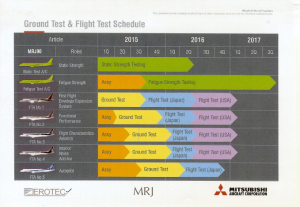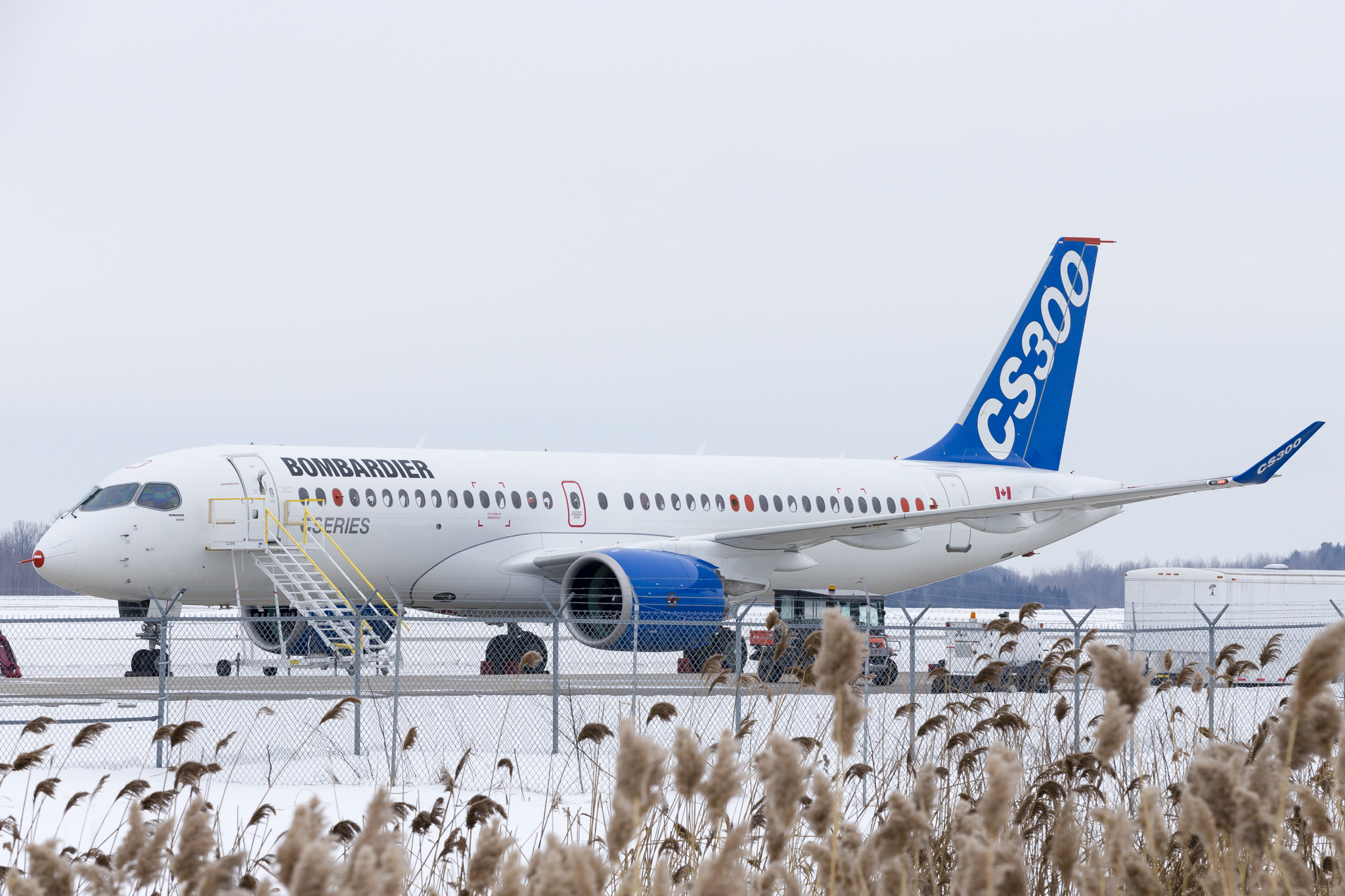Leeham News and Analysis
There's more to real news than a news release.
Leeham News and Analysis
- Boeing ponders 16/mo production rate for 787
- At long last, Boeing appears near certification and EIS for 777X
- Air India Flight 171 Preliminary Crash Report Is Unclear Regarding Pilot Actions
- Bjorn’s Corner: Air Transport’s route to 2050. Part 30.
- It’s official: MTU’s engine leader named CEO of Airbus Commercial from Jan. 1; future of Open Fan and A220-500 shifts to him
Mitsubishi opens Seattle Engineering Center ahead of MRJ90 first flight
August 3, 2015, © Leeham Co.: Mitsubishi Aircraft Corp. today opened its Seattle Engineering Center jointly with local company AeroTEC in advance of the first flight of the MRJ90 in September or October. During the second quarter of next year, four of five MRJ Flight Test Vehicles will be domiciled in Moses Lake in Central Washington for the bulk of the flight testing over the following year. Entry into service is planned for 2Q2017 with launch customer All Nippon Airways.
The engineering center represents the first in Washington State for an aircraft OEM other than Boeing. Mitsubishi will assign 50 engineers from Japan to the new SEC, in South Seattle a short distance from Boeing Field. One hundred engineers will be hired locally.
AeroTEC and Mitsubishi began discussing working together only last January, said president Lee Human, who added that the seven months from January to the opening of the SEC today was remarkable for the speed in which negotiations, contracts, permits and hiring was achieved.
Posted on August 3, 2015 by Scott Hamilton
Bjorn’s Corner: What Paris Air Show taught us about East and West.
25 June 2015, © Leeham Co: With a few days in the office one can look back at Paris Air Show with a bit of perspective. So what are the impressions?
It was surprising how many orders Airbus and Boeing landed. Both had played down the expectations, telling that it will be a decent show but nothing close to record. Yet both were booking orders or commitments which were better than expected going into the PAS. Read more
Posted on June 26, 2015 by Bjorn Fehrm
AirAsia, Bjorn's Corner, Boeing, Bombardier, Comac, CSeries, Farnborough Air Show, Future aircraft, GE Aviation, Irkut, Paris Air Show, Pratt & Whitney, Rolls-Royce, Sukhoi, United Aircraft, YAK
737 MAX, 787, A320NEO, A330neo, Airbus, Boeing, Bombardier, Comac, CSeries, GE, Pratt & Whitney, Rolls-Royce
Airbus COO faces production challenge vs bulging order book
Subscription required.
Now open to all Readers.
Introduction
June 15, 2015, Paris Air Show, c. Leeham Co. Airbus, like Boeing, is faced with an embarrassment of riches: too many  orders for the A320 and A350 production rates that have been announced. There’s pressure from the top commercial officer to hike rates, but the president and chief operating officer says not so fast.
orders for the A320 and A350 production rates that have been announced. There’s pressure from the top commercial officer to hike rates, but the president and chief operating officer says not so fast.
Tom Williams was elevated to the presidency only a few
months ago from his position as EVP-Programs, where he was in charge of production and the Airbus supply chain. Williams, a Scotsman and the first non-French or non-German to be president and COO of Airbus Commercial, ruefully observes he didn’t give up the production and supply chain duties with his new title.
Although Williams agrees with John Leahy, chief operating officer-customers, that demand indicates higher rates are needed for the A320 and A350, the demands on the supply chain for Airbus, as well as the other airframers, also demands caution.
- Summary
- Decision end of this year or early next on A380 production rates.
- A380neo launch aid reported—but it’s premature.
- No decision yet on greater than 50 A320 production rate per month.
- Pondering hike in A350 production rate beyond the 10/mo announced.
- Cabin suppliers a top concern.
Posted on June 15, 2015 by Scott Hamilton
Airbus, Boeing, Bombardier, CFM, Comac, Embraer, Irkut, Mitsubishi, Paris Air Show, Sukhoi
777X, 787, A320, A320NEO, A350, A380, Airbus, Boeing, John Leahy, Tom Enders, Tom Williams
Paris Air Show: Qatar and others
Subscription required.
Introduction
June 1, 2015, c. Leeham Co. It could be called the Qatar Airways Air Show.
Qatar Airways plans to have five airliners on display at the Paris Air Show in two weeks: the Airbus A319, A320, A350, A380 and the Boeing 787. The carrier hasn’t  announced whether it will provide an aerial display as it has at previous air shows, but Qatar may well have more airliners there than Airbus or Boeing.
announced whether it will provide an aerial display as it has at previous air shows, but Qatar may well have more airliners there than Airbus or Boeing.
As for manufacturers other than Airbus and Boeing, we don’t expect anything of consequence from these.
Summary
- Irkut, COMAC, Mitsubishi, Sukoi and ATR are other major aircraft producers that will be at the Paris Air Show.
- Engine makers CFM International, GE Aviation, Rolls-Royce, Pratt & Whitney and Engine Alliance will also be there.
- An update on Airbus expectations.
Posted on June 1, 2015 by Scott Hamilton
Airbus, ATR, Boeing, Bombardier, CFM, Comac, Embraer, Emirates Airlines, Irkut, Mitsubishi, Paris Air Show, Pratt & Whitney, Premium, Qatar Airways, Rolls-Royce, Sukhoi
787, A319, A320, A350, A380, Airbus, ATR, Boeing, CFM, Comac, Emirates Airlines, Engine Alliance, GE Engines, Irkut, Mitsubishi, Paris Air Show, Pratt & Whitney, Qatar Airways, Rolls-Royce, Suhkoi, Tim Clark
Bombardier CS300 analysis vs A319neo, 737-7
By Bjorn Fehrm
Subscription required
Introduction
March 29, 2015, c. Leeham Co: Bombardier’s big bet in the aeronautics sector, CSeries, is well into flight testing, now more than half way toward the 2,400 hours required by Transport Canada before certification can be granted. The first aircraft to be certified will be the smaller 110 seat CS100 but the market is most interested in the larger 135 seat CS300, which has 63% of present orders and commitments, Figure 1.
Bombardier’s new CEO, Alan Bellemare, told reporters last week that the CS100 would be certified during 2015 with entry into service slipping into 2016. The CS300, which is a direct challenger to Airbus’ A319neo and Boeing’s 737-7, should follow six months after CS100. With the CS300 in flight testing and going into service next summer, we decided to have a deeper look at CS300 and its competitors.
Summary
- A319 and 737-7 are shrinks of the market’s preferred models, A320 and 737-8, and as such not the most efficient models.
- The CS300 is the series center-point and it shows. The modern design beats the Airbus and Boeing designs on most counts.
- Part of the modern concepts in CSeries is the well-conceived Pratt & Whitney PW1000G geared turbofan.
- PW’s 73 in fan version of the PW1000G for CSeries is slightly less efficient that the 81 in version for A319neo but CS300 lower weight makes sure this is more than compensated for.
Posted on March 29, 2015 by Bjorn Fehrm
Airbus, Boeing, Bombardier, CFM, China, Comac, CSeries, Embrarer, GE Aviation, International Aero Engines, Pratt & Whitney, Premium, Sukhoi, United Aircraft, YAK
737, 737 MAX, 737-7, 737NG, A319neo, A320, A320NEO, Airbus, Boeing, Bombardier, CFM, Comac, CSeries, E-195 E2, E-Jet E2, Embraer, GTF, LEAP-1A, Leap-1B, Pratt & Whitney
Bombardier sees solid future for CRJ
March 20, 2015: C. Leeham Co. Bombardier’s current challenges don’t end with the CSeries. The company has seen its once-dominate positions in the regional jet and turbo prop markets decline precipitously.

Ross Mitchell, VP of Business Acquisition and Commercial Airplanes, Bombardier. Photo: Fleigerfaust.
The CRJ struggles in its sales against the Embraer E-Jet. The Q400’s market share of the turbo prop sector has declined to a mere 10% of the backlog vs ATR.
Still, Ross Mitchell, vice president of Business Acquisition and Commercial Aircraft for Bombardier, gave a spirited defense and upbeat outlook of both products during last week’s ISTAT conference in Phoenix. In a one-on-one interview the next day, we posed a series of questions about the CRJ and the Q400. We reported on the Q400 yesterday. Today’s report is about the CRJ.
CRJ’s future
Mitchell said the CRJ has a lower unit cost than the rival Embraer E-175 and E190, the direct competitors to the CRJ-700/900 used most in the USA, where labor Scope Clauses limit the size and number of airplanes that may be operated by the regional airlines on behalf of the legacy carriers.
Posted on March 20, 2015 by Scott Hamilton
Bombardier, Embraer, ISTAT, Mitsubishi, Sukhoi
Bombardier, CRJ-1000, CRJ-700, CRJ-900, E-175, E-190, E-Jet, E-Jet E1, E-Jet E2, Embraer, ISTAT, John Slattery, Mitsubishi, MRJ90, Q400, Ross Mitchell, SSJ100, Sukhoi
Order cycle may have peaked for mainline single-aisles, but smaller jet cycle booming
Feb 24, 2015: The mainline jet orders get the headlines, and the focus on the order cycle, but the smaller jets have yet to see their order cycle peak.
Goldman Sachs downgraded Boeing to a Sell this week, in part on the theory that orders for the single-aisle, mainline jets have peaked and an oversupply is developing in its competition with Airbus.
The oversupply—if it develops—will only get worse as Airbus and Boeing ramp up production. Airbus has announced plans to take A320 family production to 46/yr next year. It’s notified the supply chain to be ready to go to 54/mo in 2018.
Boeing has announced plans to go to a firm rate of 52 737s per month in 2018. It’s considering 58/mo in 2019 and 63/mo in 2020, according to supply chain sources. We expect Airbus to match.
Given the long backlogs for mainline jets, out to 2020 and even beyond, it’s natural to conclude the order cycle has peaked for the time being. At the Pacific Northwest Aerospace Alliance conference Feb. 11 in Lynnwood (WA), Boeing’s VP Marketing Randy Tinseth said the company sees the need for 4,000 more orders for the A320/737 class in the next five years. This averages 800 per year, or about 440 per year for the A320 and 360/yr for the 737 at the recent split of 55%/45% for the two airplanes. This is down dramatically from recent order history and well below the book:bill of the production rates.
If the mainline order cycle has peaked, it’s a different story for the smaller jets in the 70-130 seat sectors.
Posted on February 24, 2015 by Scott Hamilton
Airbus, Boeing, Bombardier, CSeries, Embraer, Mitsubishi, Sukhoi
Airbus, Boeing, Bombardier, CRJ, CSeries, E-Jet, Embarer, ERJ, Mitsubishi, SSJ, Sukhoi
Is next airliner a single or dual aisle?
By Bjorn Fehrm
19 Feb 2015: There has been much speculation over the last weeks and months what Boeing is up to in the segment 200 to 250 seats, also know as the “757 replacement market“. The speculations over Airbus response are also vivid. One of the reasons is that apart from this segment the landscape of which civil airliners will be produced over the next 10-15 years is pretty much settled; Cseries is on final stretch of development, A320neo is flying while 737 MAX flies next year. A330neo will fly 2017 as will 787-10. A350-1000 start testing in 2016 with deliveries in 2017 and 777-9X flies 2019 with deliveries 2020.
Apart from an announcement by Russia and China that they will design a 250-280 seat widebody there is only the “757 replacement” segment which can result in a clean sheet approach from the major OEMs. Around this questions has arisen a lot of speculation about possible short and long term solutions. Having done a lot of checking of these alternatives with our proprietary model, we have learned that:
- The 757 has an attractive capacity but is around 25% less efficient than the new generation of single aisle, A321neo or 737 MAX9, on the routes they can fly.
- Airbus could stretch the A321 into something we called A321neoLR and indeed Airbus was working on it, it is now in the market as A321LR.
- While 737 MAX9 limitations prohibited a response from Boeing we compared Airbus A321neoLR to what Boeing might come up with in their clean sheet design studies NSA (New Single Aisle) and NLT (New Light Twin)
- Subsequently a 757 MAX was proposed but Boeing immediately declared that it does not work for them and we explained why.
- Based on Boeing’s statement that the market is looking for something “a little larger than a 757” we looked into a 767 MAX with 767-200 as the airframe (it would be readily available from the KC-46 program) with GEnx-2B engines (from 747-8, they would fit). Once again it does not pass the first check, efficiency would not be much better than 757.
Posted on February 19, 2015 by Bjorn Fehrm
Regional operations with the Turboprop, prop-jet or Jet
- We examined the future of turboprop airliners Jan. 5, 2015, analyzing the backlogs of Bombardier and ATR–and the ATR overwhelming dominance of the current turboprop sector. This is the second of a series looking at this sector.
By Bjorn Fehrm
Subscription required
Introduction
08 Feb 2015: Passenger traffic is growing the world over on a regional, domestic and international level. For domestic and international airlines the choice of mainline transport aircraft is clear today: there are only two vendors, Boeing and Airbus, and they produce similar products.
For regional transportation there is more choice. First of all, one can chose type![]() of aircraft, turboprop or jet. Within jet, there are several OEMs that are active. The choice in turboprop is more restricted. In practice, the choice stands between the classical turboprop with ATR and a faster type from Bombardier, the Q400 “Prop-Jet” as it is called, as its speed lands between the classical turboprop and regional jet.
of aircraft, turboprop or jet. Within jet, there are several OEMs that are active. The choice in turboprop is more restricted. In practice, the choice stands between the classical turboprop with ATR and a faster type from Bombardier, the Q400 “Prop-Jet” as it is called, as its speed lands between the classical turboprop and regional jet.
The question is, what are the real differences between them in terms of design, passenger comfort and economics and what is the right choice for a market segment? We will take a deeper look into this by analyzing the ATR72 as the classical turboprop, the Bombardier Q400 as the Prop-Jet and CRJ700 as the regional jet.
Summary:
- The ATR72-600, Bombardier Q400 and CRJ700 are all about the same size, around 70-80 seats single class or 60-70 seats dual class.
- They offer different comfort levels, and it is not all about speed.
- In developing the economics in two steps we seek the crossover points between the different types.
Posted on February 8, 2015 by Bjorn Fehrm
Single-aisle values, lease rates stable; smaller mainline jets struggle
Special to Leeham News and Comment
By Gueric Dechavanne
Collateral Verifications
Feb. 8, 2015: Apart from a few unfortunate events, the industry has been moving along quite nicely so far in 2015. Used single-aisle aircraft values and lease rates have remained somewhat stable for the most part whilst new aircraft continue to be in demand which means a competitive landscape for those looking to invest in the types. On the in-production front, Airbus A319s, A330-200s, and Boeing 737-700s continue to struggle to find homes as many operators look to their larger siblings for lift. Airbus A320s, 321s, 330-300s, A350-900, Boeing 737-800s, 777-300ERs, and 787s continue to be the aircraft of choice, which in turn has stabilized and even strengthened values and lease rates for most. We are starting to see some softening in 777 values, which we believe is due to the competitive nature of some of the Boeing campaigns to fill the order book until the 777X enters service.




